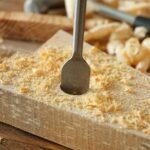If you’ve ever wondered what the acronym “PVA” stands for in woodwork, you’re not alone. PVA stands for polyvinyl acetate, which is a type of aliphatic resin adhesive commonly used in woodworking. This versatile and widely-used adhesive has become an essential tool in woodwork due to its numerous benefits and applications.
Polyvinyl acetate (PVA) is a synthetic polymer that has gained popularity in the woodworking industry for its strong adhesive properties and ease of use. Understanding the chemistry behind PVA is crucial in comprehending its effectiveness as an adhesive in various woodworking projects. From its bonding capabilities to its water-based composition, PVA offers unique advantages that make it a go-to choice for many woodworkers.
In this article, we will delve into the uses and application of PVA in woodwork, explore the benefits of using PVA in woodworking projects, discuss different types of PVA adhesives for various woodworking applications, provide tips on properly using PVA, address common mistakes to avoid when using PVA, compare PVA with other types of wood adhesives, and emphasize the importance of PVA in woodworking.
Whether you are an experienced woodworker or new to the craft, understanding the significance of PVA in woodwork is essential for achieving successful and durable results.
Understanding the Chemistry of PVA
PVA, in the context of woodworking, stands for Polyvinyl Acetate. It is a type of adhesive that is commonly used in various woodworking projects due to its strong bonding properties and versatility. Understanding the chemistry of PVA is essential for woodworkers to fully grasp its capabilities and limitations.
Polyvinyl acetate is a synthetic polymer that is created through the polymerization of vinyl acetate monomers. The resulting compound has excellent adhesive properties, making it ideal for use in woodworking applications. When PVA is applied to wood surfaces, it forms strong bonds as it penetrates the porous structure of the material, resulting in a durable and reliable connection.
One important aspect of the chemistry of PVA is its emulsifying properties, which allow it to mix easily with water. This makes PVA adhesives easy to apply and clean up after use, contributing to their popularity among woodworkers. Additionally, PVA adhesives also have the ability to bond with a variety of materials beyond just wood, further extending their usefulness in different types of construction and craft projects.
| Chemical Properties | Application |
|---|---|
| Polymerization of vinyl acetate monomers | Forms strong bonds when applied to wood surfaces |
| Emulsifying properties | Mixes easily with water, easy application and cleanup |
| Versatility | Bonds with various materials beyond wood |
The Uses and Application of PVA in Woodwork
PVA, which stands for Polyvinyl Acetate, is a versatile and widely used adhesive in the woodworking industry. Its popularity is due to its strong bonding properties, ease of use, and versatility across different types of wood projects. In this section, we will explore the various uses and application techniques of PVA in woodwork.
General Uses
One of the primary uses of PVA in woodwork is for bonding wooden surfaces together. Whether it’s for joining two pieces of wood or attaching veneer to a substrate, PVA adhesives provide a strong and durable bond that can withstand the test of time. Additionally, PVA can also be used for laminating surfaces, edge banding, and as a general-purpose wood glue for various woodworking applications.
Application Techniques
When applying PVA in woodwork, it is important to follow proper techniques to ensure optimal bonding and long-lasting results. This includes properly preparing the surfaces to be bonded by ensuring they are clean, dry, and free from any contaminants or residues. Additionally, applying an even coat of PVA adhesive using a brush or roller helps in achieving uniform adhesion.
Specialized Applications
In addition to general woodworking tasks, PVA adhesives also have specialized applications such as joinery work (e.g. dovetail joints or mortise and tenon joints), cabinet making, furniture construction, and woodturning projects. PVA’s versatility allows it to be used across a wide range of woodworking disciplines, making it an essential adhesive for both beginner and experienced woodworkers alike.
Understanding the specific uses and application techniques of PVA in woodwork is essential for achieving successful woodworking projects. Whether it’s for general bonding purposes or more specialized applications like joinery work or furniture construction, utilizing PVA adhesives can significantly improve the quality and durability of your woodworking creations.
Benefits of Using PVA in Woodworking Projects
PVA, which stands for Polyvinyl Acetate, is a type of adhesive that has become a staple in woodworking projects due to its numerous benefits. Here are some of the advantages of using PVA in woodworking:
- Versatility: PVA can be used with various types of wood, making it suitable for a wide range of woodworking projects.
- Strong Bond: When properly applied, PVA creates a strong and durable bond between wood pieces, ensuring the longevity of the project.
- Easy Clean-Up: PVA is water-soluble when wet, making it easy to clean up any excess adhesive with water before it dries.
In addition to these benefits, using PVA in woodworking projects also offers time efficiency and cost-effectiveness. Its fast drying time allows for quicker assembly of wood parts, while its affordability makes it an attractive option for both professional woodworkers and hobbyists alike.
Overall, the use of PVA in woodworking projects provides numerous advantages that contribute to the success and quality of the finished product. Whether it’s for simple DIY projects or more complex woodworking endeavors, PVA proves to be a reliable and efficient adhesive choice.
In summary, the benefits of using PVA in woodworking projects make it an essential tool for anyone working with wood. Its versatility, strong bond, easy clean-up, time efficiency, and cost-effectiveness all contribute to its importance in achieving successful and high-quality woodworking results.
Types of PVA Adhesives for Different Woodworking Applications
PVA adhesives, or polyvinyl acetate adhesives, are widely used in woodworking due to their versatility and strong bonding capabilities. There are different types of PVA adhesives available for various woodworking applications, each designed to cater to specific needs and requirements. Here are some common types of PVA adhesives used in woodworking:
- Standard PVA: This type of PVA adhesive is ideal for general woodworking projects such as furniture making, cabinet assembly, and wood craft projects. It offers a strong bond and dries clear, making it suitable for a wide range of applications.
- Waterproof PVA: For outdoor furniture or projects that will be exposed to moisture, waterproof PVA adhesive is the go-to choice. It provides a strong bond even in wet conditions and prevents the wood from warping or deteriorating due to water exposure.
- High Strength PVA: When working with hardwoods or heavy-duty woodworking projects that require extra strength and durability, high strength PVA adhesive is the best option. It offers a stronger bond compared to standard PVAs and can withstand heavier loads.
Understanding the different types of PVA adhesives available is crucial in selecting the right adhesive for your woodworking project. By choosing the appropriate type of PVA adhesive, you can ensure that your project is not only securely bonded but also resistant to environmental factors such as moisture and heavy use.
When using any type of PVA adhesive in woodworking, it is important to follow the manufacturer’s instructions for application and drying times to achieve optimal results. Additionally, it’s essential to store PVA adhesives properly in a cool, dry place to maintain their effectiveness over time.
As a versatile and reliable bonding agent, PVA adhesives have become an essential component in the woodworking industry, providing craftsmen with the means to create durable and long-lasting woodwork pieces. Whether it’s a small craft project or a large-scale furniture assembly, choosing the right type of PVA adhesive can make all the difference in achieving professional-quality results.
Tips for Properly Using PVA in Woodwork
Proper Application Techniques
When using PVA in woodwork, it’s important to apply the adhesive properly to ensure a strong and long-lasting bond. Make sure to spread the PVA evenly on both surfaces that you are joining together. Use a small brush or a roller to apply the adhesive, and make sure to cover the entire surface area. This will help to create a uniform bond and prevent any weak spots in the joint.
Clamping and Drying Time
After applying the PVA adhesive, it’s crucial to clamp the pieces of wood together tightly. Clamping ensures that there is constant pressure on the joint as the PVA dries, which helps create a strong bond between the two surfaces.
Additionally, be patient with the drying time of PVA glue. While it may feel dry to touch after a short period, it’s best to leave the glued pieces clamped together for at least 24 hours to ensure that the bond is fully set.
Clean-Up and Storage
Clean up any excess PVA adhesive immediately with a damp cloth before it dries. Once dried, PVA can be difficult to remove from surfaces, so it’s important to act quickly if there are any spills or drips. Additionally, make sure to store your PVA adhesive in a cool and dry place away from direct sunlight. Proper storage will ensure that your PVA remains effective for future woodworking projects.
Common Mistakes and How to Avoid Them When Using PVA
When working with PVA in woodwork, it is important to be aware of common mistakes that can occur during its application. One common mistake is using too much or too little adhesive. Using too much PVA can lead to messy, excess glue squeezing out of the joint, while using too little may result in a weak bond. It is essential to follow the manufacturer’s recommendations for the appropriate amount of adhesive to use for the specific woodworking project.
Another mistake to avoid when using PVA in woodwork is not allowing enough clamp time for the adhesive to set. It is crucial to give the PVA enough time to dry and form a strong bond between the wood pieces being joined together. This often requires leaving the clamps on for at least 30 minutes to an hour, depending on the type of PVA adhesive being used.
Lastly, failing to properly prepare the wood surfaces before applying PVA can result in a weaker bond. It is important to ensure that the wood surfaces are clean, dry, and free from any debris or contaminants that could interfere with the adhesive’s effectiveness. Failing to do so can lead to a compromised bond between the wood pieces.
| Common Mistake | How to Avoid |
|---|---|
| Using too much or too little adhesive | Follow manufacturer’s recommendations; use appropriate amount |
| Not allowing enough clamp time for adhesive to set | Leave clamps on for recommended time; consult manufacturer guidelines |
| Failing to properly prepare wood surfaces before applying PVA | Ensure surfaces are clean, dry, and free from debris or contaminants |
Comparing PVA With Other Types of Wood Adhesives
When it comes to woodwork, there are various types of adhesives that can be used to join pieces of wood together. PVA, or polyvinyl acetate, is one of the most common types of wood adhesives and is often compared to other options such as epoxy, polyurethane, and cyanoacrylate. Understanding the differences between these adhesives can help woodworkers make informed decisions when choosing the right adhesive for their projects.
One of the main advantages of PVA over other types of wood adhesives is its ease of use. PVA is water-based, making it easy to clean up with water before it dries. It also has a longer open time compared to some other adhesives, allowing for more flexibility in assembly. Additionally, PVA is non-toxic and does not emit harmful fumes, making it a safer option for woodworking projects.
Another important consideration when comparing PVA with other wood adhesives is its strength and durability. While epoxy and polyurethane adhesives may offer stronger bonds in certain applications, PVA still provides a reliable and strong bond for most woodworking projects. It also has good resistance to temperature changes and moisture, making it suitable for both indoor and outdoor use.
In terms of cost, PVA also offers an advantage over many other types of wood adhesives. It is generally more affordable than epoxy and polyurethane adhesives, making it a budget-friendly option for hobbyists and professional woodworkers alike. However, it’s important to consider the specific requirements of each project when deciding which type of adhesive to use.
Overall, while there are different types of wood adhesives available on the market, PVA remains a popular choice for woodworking due to its ease of use, strength, versatility, and affordability. Understanding the specific properties and advantages of PVA compared to other types of wood adhesives can help woodworkers make informed decisions when selecting the right adhesive for their projects.
Conclusion
In conclusion, PVA, which stands for Polyvinyl Acetate, is a crucial component in the world of woodworking. Its unique chemistry and adhesive properties make it an ideal choice for various woodworking projects. PVA is versatile and can be used for everything from basic wood joining to more advanced furniture making and cabinetry.
One of the key benefits of using PVA in woodworking is its strong bonding capabilities. Whether you are working with hardwoods or softer woods, PVA provides a reliable and durable bond that will stand the test of time. Additionally, PVA dries clear, making it ideal for applications where aesthetics are important.
When using PVA in woodworking, it is important to follow some key tips to ensure successful results. Proper application techniques, clamping pressure, and drying times all play a role in achieving the best bond possible with PVA. By understanding these factors and avoiding common mistakes such as using too much adhesive or not allowing proper drying time, woodworkers can make the most of this versatile adhesive.
Frequently Asked Questions
What Does PVA Mean in Wood?
PVA stands for polyvinyl acetate, which is a type of adhesive commonly used in woodworking. It is known for its strong bonding and versatile applications in wood joinery and construction.
What Is PVA Wood?
PVA wood refers to wood that has been bonded or treated with polyvinyl acetate adhesive. This adhesive is often used in woodworking for its fast setting time, ease of use, and ability to bond porous materials like wood.
Is PVA Any Good for Wood?
Yes, PVA is considered good for wood due to its strong bonding strength, versatility, and ease of use. It can be used for various woodworking applications such as laminating, veneering, edge banding, and general assembly due to its reliable performance on wood surfaces.

Hi everyone! I’m a woodworker and blogger, and this is my woodworking blog. In my blog, I share tips and tricks for woodworkers of all skill levels, as well as project ideas that you can try yourself.





